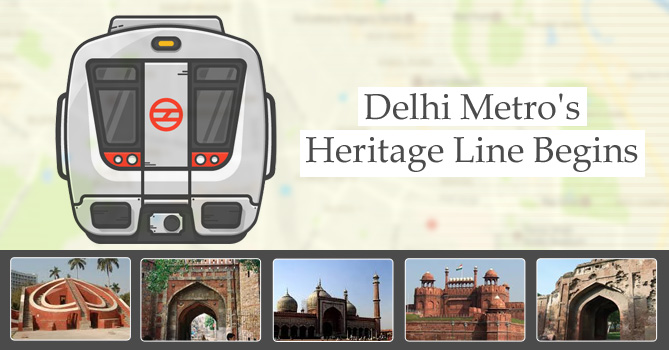They say that the Indian capital is a city of Dilwalas. Be as it may, Delhi is certainly in the hearts of the Indians. Our capital is a culturally rich, historic city that is dotted with important monuments and iconic landmarks. The newest and the best way to visit these landmarks is Delhi Metro’s new ‘Heritage Line’.
Introducing The Heritage Line
Yesterday, 28 May, 2017, Union Urban Development Minister M. Venkaiah Naidu and the Chief Minister of Delhi Arvind Kejriwal together inaugurated the Heritage Line of Delhi Metro. The Heritage Line comes as a boon to hassled tourists who would otherwise spend hours stuck in snarling traffic jams. The Heritage Line has four stations including the Kashmere Gate station, Delhi Gate, Jama Masjid, and Lal Quila stations. The maiden journey of this Heritage Line Metro was between the ITO and Kashmere Gate stations. Throwing open this line will make it easier for tourists and commuters to get to many parts of the Walled City – Old Delhi. Old Delhi with its iconic Delhi Gate, Sunday book market in Daryaganj, Jama Masjid, historic Red Fort, the buzzing lanes of Chandni Chowk, St. Stephen’s Church, and Begum Samru’s Palace, will now be accessible through the Metro.
Metro Across The Capital
The Heritage Line is an extension of the violet line which is in all a 9.3 kilometre stretch. The section between Janpath, Mandi House, and ITO were already functional before the inauguration of this Heritage Line. There is now a 217 kilometre long metro network in Delhi-NCR connecting some 162 stations (including the Heritage Line). The Delhi Metro also surpassed the Moscow and Tokyo mass transit networks with this.
Work on the Heritage Line received clearance from the NMA (National Monuments Authority) on February 13, 2013 and this line has been in the works ever since. The Commissioner of Metro Railway Safety (CMRS) also conducted a two day inspection on this 5.17 kilometre corridor last week and gave the line his go-ahead for a formal launch. This line has also received a safety certification from an ISA (Independent Safety Assessor). In fact, news reports suggest that the launch was scheduled for December 2016 but was delayed due to a shortage of labour and due to the demonetization undertaken by the government.
With the inauguration of this line Kashmere Gate is expected to take off a great deal of the load that is shouldered by Rajeev Chowk and Central Secretariat stations. Commuters traveling from Samaipur Badli to HUDA City Center, on the Rithala to Dilshad Gate route and on the Faridabad line can now change at Kashmere Gate. It seems likely that this station will soon be the largest interchange station. Currently, Rajeev Chowk witnesses a footfall of about 5 lakh commuters each day. The stations on this line will also help ease the load on the Chandni Chowk and Chawri Bazar stations (Yellow Line).
During the launch, Mr. Naidu emphasized on the need for a robust public transport system to replace the growing number of cars and to tackle the menace of air pollution in the capital. He also said that the government was keen on constructing a cycle track throughout the capital city.
Inside The Walled City
The Walled City of Shahjahanabad is the heart of Delhi’s quintessential culture. It was constructed by the Mughal Emperor Shah Jahan in 1693. The three stations on the Heritage Line have been planned to provide tourists easy access to the rich historic legacy of this part of Delhi.
Currently the Metro transit system operational in different cities adds up to about 346 kilometres. 530 kilometres more are under construction and 800 kilometres of Metro connectivity is still in the planning stage.
Related Information




